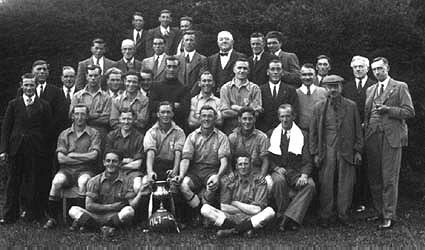
The name of the village has changed many times during its history and there are two theories behind its origin. The main (and accepted) theory is that the original name was Dudda's Tun, meaning the farmstead (manor or dwelling place) of a person or tribe called Dudda.
A second theory is that the name relates to the appearance of the site: 'Dodden' or 'Dod(d)' meant 'to make the top or head of anything blunt or bare' in middle English; similarly, 'dodd' or 'dodle' meant 'a lump, clump or bunch' in Fresian. These interpretations could relate to the wooded hills around the area. Early references to the Doddington name include Duddintun, Dodintua (c. 1100), De Dudinton (c. 1180), Dodinton (c. 1261) and Dodynto (c. 1270).
The earliest human presence can be traced back to earthworks
at Sharsted Court, excavated in 1825 and 1880, and considered
to be an Iron Age Belgic fort (100BC-43AD). Also found nearby
were ashes, human bones, urns, remnants of swords and spurs, broken
pottery and gold coins - which indicate subsequent Roman occupation.
Anglo Saxon skeletons and iron spear heads were found in the early
1890's at Chapman's Gravel Pits.
There
has been a settlement on the site of the present village dating
back to the 11th century and the earliest records are in the Domesday
Book. These relate to the "Saxon parish of Dodeham which
was subordinate to the manor at Teynham, being within that 'Hundred'
(together with the parish of Linsted)".
It is interesting to see that the population of the village
over the last 150 years has changed little - from 473 in 1841
to 550 in 1991; however, in 1841 there were only 85 houses, compared
with 201 in 1991. Between the years 1871 and 1881, the number
of houses dropped from 115 to 105 due to 'tidying up' of the estate
of Doddington Place; demolitions included Whitemans (see page
9) and a farm which lay beyond the church.
See
a map of Doddington from 1876
The census of 2001 recorded a population for Doddington of 557 and 214 households
Doddington's villagers took part in more local pastimes in the early 1900's than they do today. However, even between the years of 1908 and 1926, many changes took place. The St. John's Ambulance Brigade suffered a 30% reduction in its membership; the Miniature Rifle Club, the Hockey Club and the Cottage Gardeners Society were no longer in existence and both the Cricket Club and the Football Club relocated from Doddington Place to other grounds. In contrast, the Chequers Slate Club, which provided locals with sickness and death benefits, had increased its membership by 150%.

Transport also changed over the period: the Lenham-Faversham Carrier, which had run three times a week, was replaced by the Maidstone-Faversham Carrier (running twice a week) in conjunction with a new bus-service, from Sittingbourne to Faversham, which ran 2-3 times daily.
In the interim, other local activities have ceased - for example, Point-to-Point and Grass Track racing and the Boxing Club; the tradition of 'beating the bounds' was last heard of in the 1940/50's, when 'Jolly' Jack Usher walked the parish boundaries ringing a hand bell to banish devils and spirits.